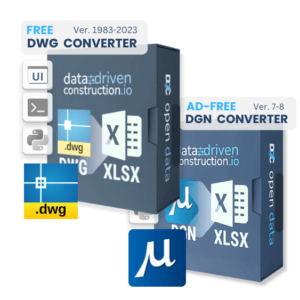Any construction project consists of object entities with attributes, to which geometric information is added using a specialized CAD editor, primarily to confirm the entity's volumetric attribute.
CAD specialists populate the database with entities by adding both attribute and geometric layers within the closed database of the CAD program. At the same time, experts from other fields take a similar approach, with the difference that their work involves the use of open databases.
At what point did the topic of BIM emerge in CAD? Let's just go over the facts:🌕 In 1994, german engineer L. Obermeyer registered the IFC format in Boston and transferred the rights to Autodesk via Mr. P. M. (CEO HOK).
🌗 In 1994 Autodesk organize together with #HOK an IAI organization (in the future buildingSMART)
🌗 In 2002, Autodesk acquired Revit - BOM product (PTC-Pro/Engineer) for $130 million from L. Raiz.
🌗 In 2003, Autodesk published White Paper #BIM, outlining engineering BOM for construction (a concept made popular by L. Raiz with his mentor S. Gaisberg in the Pro/ENGINEER product during the 90s).
🌘 In 2012, Nemetschek Group trademarked #openBIM.
🌑 In 2018, buildingSMART International replaced the Nemetschek Group logo OPENBIM® and register the new logo and the openBIM® acronym itself in the new registered mark.
As a result, if we go by the fact, all modern concepts of data processing in the construction industry: IFC, BIM, openBIM, closedBIM, buildingSMART were created by CAD vendors. But at the same time, CAD vendors have adopted these ideas either from other industries or bought them as startups: Autodesk is not the creator of Revit and BIM (and also not #AutoCAD, AutoCAD Architecture, Navisworks, Civil 3D, and Advanced Steel). Autodesk buys CAD (BIM) solutions from startups. Similarly, BuildingSMART is not the creator of the #IFC and openBIM®; rather, it offers certification, access, and committee membership to expand the originally mechanical engineering-based IFC-STEP scheme.
In other industries, by the early 2000s most data on entities and their attribute composition were already stored in open databases and processed with open access. However, in CAD databases access to data about entities and their attributes was and is closed, and few CAD vendors are willing to provide full access to the CAD program database. With the purchase of Reivit-BOM, the situation with the closed type of data led to the emergence of the BIM concept, which implies special specialized access and processing of attribute information for entities.

A complete map of the history of BIM concepts:
https://miro.com/app/board/o9J_laML2cs=/
A 20 minute video on the history of the emergence of BIM concepts in the construction industry:
DataDrivenConstruction guidebook:
https://datadrivenconstruction.io/index.php/books/





















